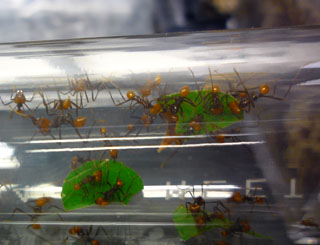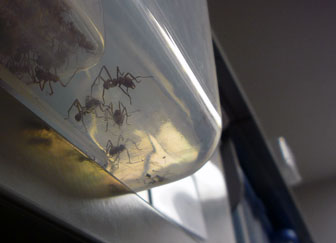
Microbes in leafcutter ant colonies could make cellulose ethanol production easier.
By Alice Rossignol and Jeff Gillies
Oct. 27, 2009
Wisconsin researchers hope six-legged fungus farmers can speed the switch from gasoline to plant-based fuels.
The farmers are leafcutter ants, and for millions of years they’ve been breaking down plants into the ingredients people now hope to use to brew environmentally friendly fuels.
By studying how plants break down in a leafcutter ant colony, we might do a better job of breaking them down in a big biofuel production facility, said Cameron Currie, a bacteriology professor at the University of Wisconsin-Madison.
“We can learn about how natural systems do it to model our own attempts to do it,” he said.
The research is a small part of the Great Lakes Bioenergy Research Center, a coalition of universities, government laboratories and a biotechnology company funded by the U.S. Department of Energy. The University of Wisconsin-Madison leads the research, with Michigan State University as a major partner.
The center’s goal is to shift the biofuels industry toward crops that are more abundant and less controversial than the industry’s current crop of choice: corn.
Ethanol producers make the fuel by fermenting plant sugars. Most of the U.S. ethanol supply comes from corn — around 98 percent, according to a 2009 report from the Government Accountability Office. That’s because the kernels are filled with starch that converts easily to sugar.
But the report says relying on corn for ethanol causes economic and environmental problems. Growing corn takes a lot of fertilizer, which can lead to an extra dose of nutrients in nearby lakes and streams. That triggers harmful algae blooms that can muck up beaches and choke out wildlife.

Leafcutter ants are native to South and Central America, but around a million live in plastic tubs in a University of Wisconsin-Madison lab.
Others worry that using corn for anything besides food could drive up the crop’s market price.
The U.S. set a mandate in 2007 to produce 36 billion gallons of biofuels by 2022. Only 14.7 billion gallons are allowed to come from corn.
So the Great Lakes Bioenergy Research Center focuses on cellulose, the most abundant molecule in all plants that gives leaves and stems their sturdy structure. Harnessing such a common and inedible plant component could make it easy to turn grasses and wood chips to ethanol.
And that would be a boon to biofuels, said Tim Donohue, the research center’s director.
“Success of cellulosic biofuels could mitigate several issues surrounding today’s technology, not the least of which are the food versus fuel debate and the economic or environmental sustainability of biofuels,” he said.
Like corn kernels, cellulose contains the plant sugars used to make ethanol. But the sugars in cellulose are locked up in a network of resilient plant fibers. Cellulosic ethanol producers rely on heat and chemicals to free up those sugars, but that’s slow and expensive and makes large-scale cellulosic ethanol production impractical.
That’s where the ants could come in handy.
Leaf-cutter ants live in huge underground colonies where they grow fungus on chewed-up bits of leaves. Once the ants eat the fungus, they haul the leaves to the colony’s dump to decompose.
“They put it on these specialized heaps,” Currie said. “It’s kind of like a compost pile.”
There are microbes in the ants’ dump that break down tough plant fibers, but nobody knows much about them, Currie said. With more research, cellulosic ethanol producers may one day use those or other natural microbes to turn plant matter into ethanol-ready sugars.
“But that’s a long way away,” he said.
The science of cellulosic ethanol isn’t the fuel’s only unresolved issue.
Switchgrass — a potential source of cellulose — is generally lighter on the land than corn, said Nathanael Greene, the Natural Resources Defense Council’s director of renewable energy policy. But we could also dump a lot of fertilizer on it and mow it while wildlife use it for habitat.
“Just because we can do it well doesn’t mean we will do it well,” Greene said.
Even if the biofuels industry gets everything right, the best way to reduce the impact of vehicle fuels is to drive cars that use less of them, Greene said. That means getting gas guzzlers off the roads.
“We need lots of solutions,” he said. “Vehicle efficiency is by far the most important in the transportation sector.”
Pingback: Cover the Planet » Blog Archive » Sheesh, just tell the bloody story